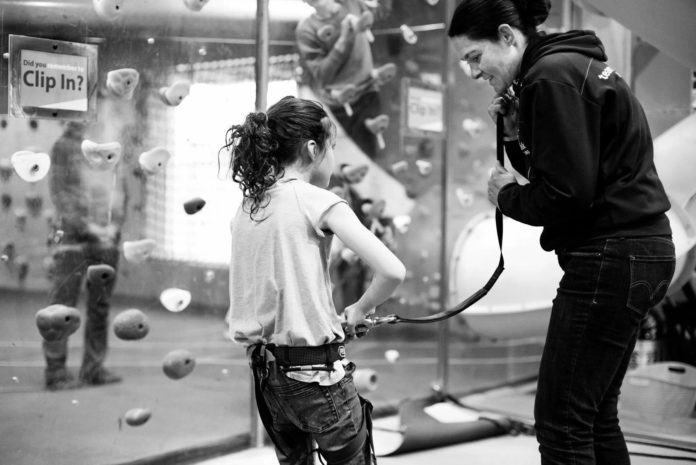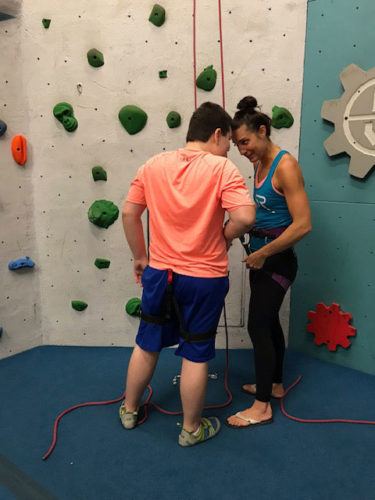
Kara LiCalsi knew that her teenage son, Dylan, liked to climb. As a young kid, Dylan was naturally athletic and often scaled anything he could in and around the house—furniture, trees, even dangerously high window sills, often to Kara’s chagrin. But since Dylan was on the autism spectrum—with an inability to communicate verbally and constantly struggling with fine-motor skills—participation in sports became increasingly difficult as Dylan grew older. “He’s not a team-sport kid, and a lot of [autistic] kids aren’t because frankly team sports are so complex; they require multi-step directions,” Kara explains. “Sometimes [team sports] require a lot of equipment, or things that you have to wear—and that, for kids that have sensory issues, it can be a lot for them.”
So, when Kara first decided to take Dylan to the Sportrock climbing gym near their home in Sterling, Virginia, the main hope was that Dylan could get some exercise, tap into his natural affinity for climbing, and not have to worry about any potential conflicts with teenage teammates who didn’t understand his autism—something that had been an issue with other sports in the past.
What Kara and Dylan found at the climbing gym, however, was not just a new sport to try; it was an activity that had potential therapeutic benefits for Dylan’s autism.
Sensory-Friendly Climbing
Climbing, with its continual engagement of multiple muscles, spatial and balance challenges, as well as its natural tactile aspects, is not dissimilar in concept from some more standard occupational therapies that many kids with Autism Spectrum Disorder (ASD)—Dylan included—might take part in daily. But, for Dylan, climbing at the Sportrock gym proved way more enjoyable than typical intervention or treatment, and the objective was not too complex: Try to get to the top of the wall.
“For [autistic kids] to have an activity that they are actually accomplishing by themselves—and then getting pride from—I was always looking for those activities,” Kara explains, adding, “Just walking into the climbing gym was such a great sensory experience for Dylan because he loved the super high ceilings—there was the cushiony floor, and all the different textures on the wall, and of course it was colorful.”
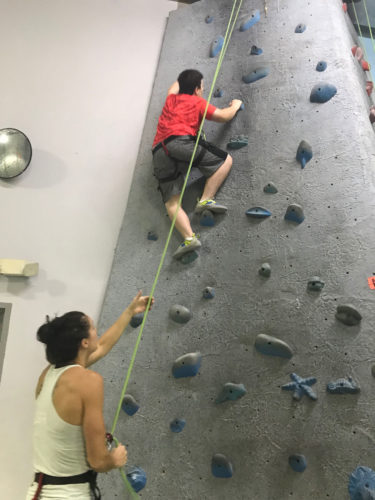
In fact, the first time Kara took Dylan to try indoor climbing, it was not a totally random endeavor, nor was Dylan the only participant with ASD at the gym at the time. The Sportrock climbing gym had arranged for a recurring and inclusive “Sensory Friendly Climbing” session, which meant the gym was opened an hour earlier than usual and exclusively accessible to kids and families on the spectrum during that time. Normally Sportrock would feature lively music and bright ceiling lights illuminating the walls, but during this Sensory Friendly hour, those elements were eliminated because such aural and visual stimuli could be upsetting to kids with ASD.
A Naturally Tactile Sport
The Sensory Friendly climbing sessions at Sportrock were the idea of the gym’s Director of Programs and Events, Molly Donelan. Donelan studied neurobiology in college and originally created a special climbing program specifically for gym patrons with Parkinson’s Disease. That Parkinson’s program immediately proved incredibly popular—with more than 25 participants at any given hour-long session (with more than 35 new participants since the initiation of the program). Typically, the program saw 7-10 participants each week, with approximately 20 “regulars.” Donelan soon began considering ways to expand and broaden the concentrated sessions. A number of parents with autistic children had already reached out to Donelan anyway to inquire about climbing at the gym as a potential activity for their kids. Since Donelan knew that there was often a sensory component to autism too, expanding Sportrock’s programming to include specific sessions for kids with ASD felt logical. “We had a therapy group come in for a little while—the therapist brought her clients in, and they found it really beneficial,” Donelan says of the autism program’s genesis. “It just clearly worked for them and I was thinking we should grow this and try Sensory-Friendly climbing for the autistic kids.”
Sportrock’s sessions for autistic climbers soon gained a following and occurred during the first Sunday of every month. That is not to say the rollout of autistic-focused climbing programming was easy at first. Autism is medically categorized as a developmental disability (that manifests in roughly 1 out of every 54 American children, according to the CDC), but Donelan notes it can differ greatly in its signs, symptoms, and expressions from person to person—with some kids on the spectrum being fully verbal and others speechless, and comorbidities can vary significantly as well. Such great variation can complicate any group organizing, and in the context of a climbing gym, this means some kids might take to ascending the walls quickly, while others might object to wearing the harnesses or donning the rubber-toed rock climbing shoes. “Overall I’d say [autistic kids] are overly sensitive to stimuli,” Donelan expounds. “But it’s not necessarily the same stimulus. So, it could be any number of things at a gym—the lights, the noise, being asked too many questions. And then the reaction to those is also varied.”
From the get-go, Donelan’s autistic-focused Sensory Friendly sessions at Sportrock necessitated additional instructors and volunteers—but the takeaway was that the program was incredibly popular. “It was a learning process,” Donelan says. “I guess I didn’t expect so many people to come that were so far on the spectrum. That definitely made it a big challenge.”
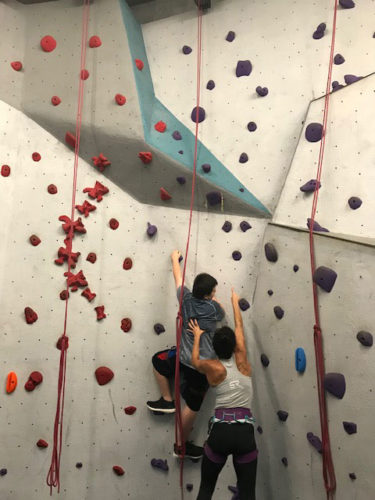
Kara LiCalsi is quite used to framing the challenges of autism in a straightforward way, as she has given several presentations to Dylan’s schoolmates on the topic. “The way that I explain [autism] is that it is a condition that basically affects the way that the brain communicates with the world,” LiCalsi says. “The number one thing that it typically interferes with is social communication. But it also can present itself in having repetitive behaviors or not being able to communicate with the world.”
Many of those ways in which autism presents itself makes climbing at a gym a suitable activity for a lot of kids on the spectrum. Plastic climbing holds vary greatly in size, shape, and texture, which allows for constant ergonomic exploration. Furthermore, the sequential nature of reaching for multiple climbing holds on a gym’s vertical wall gives the activity a naturally repetitive kinestheology—and it’s easy to track a kid’s progress and improvement. Communication is also important in climbing, from employing initial safety commands to verbally conversing about certain moves throughout an ascent during a gym session.
To Donelan, Dylan’s progress is proof of climbing’s potential effectiveness for kids on the autism spectrum. “He couldn’t put a harness on, or the shoes,” Donelan recalls of Dylan’s initial climbing experience. “But after probably six or seven sessions with him, he was climbing to the top six times during the hour. Each week it was like one step further, one step further.”
The Fun Factor
Sportrock is not the only outlet utilizing climbing as a type of promoted activity for autistic kids and their parents. One entity that promotes climbing is a Colorado-based nonprofit, Autism Climbs. The organization was started in 2015 shortly after founder Yisha Wagner learned of her own son’s autism diagnosis. What followed was a “very confusing experience” of getting contradictory advice about autism treatment and therapy from different medical professionals, Wagner remembers. Amid that “difficult journey,” Wagner decided on a whim to take her young son climbing at a local rec center. In her opinion, the benefits of climbing were evident immediately—most notably because her son climbed until he was completely exhausted and it “seemed to balance and stimulate him.” On the way home, Wagner recalls, her son “was chatty and talkative, which at the time was entirely out of character for him.”
Wagner’s overarching goal in creating Autism Climbs was to build a community for people and families who are impacted by autism or simply interested in the subject. The organization arranges monthly meet-ups at climbing gyms and works with other organizations such as Climbing For Life and Regis University’s School of Physical Therapy. Occasionally Autism Climbs also hosts outdoor climbing excursions to Colorado’s Clear Creek Canyon Park, and Wagner notes that she never explicitly asks parents which of their kids might be on the autism spectrum; rather, Wagner’s aim with the organization is more festive and less straightforwardly therapeutic. “I just want to share joy with the autism world,” Wagner explains. “I felt there was enough, ‘Oh, we have it so hard!’ I just wanted to celebrate it a little bit.”
Wagner is quick to clarify that therapy and support are important for many kids on the spectrum—and she thinks climbing certainly could have great physical and cognitive benefits. Yet, Autism Climbs promotes mainly on the concept of encouragement. This is important, according to Wagner, since the autism community is considerably divided on the use of medication and therapies for treatment, and there is a constant split between advocates of various medical offerings and more natural, holistic approaches for treating autism. The value of encouragement is something that the autism community is far more unified on.
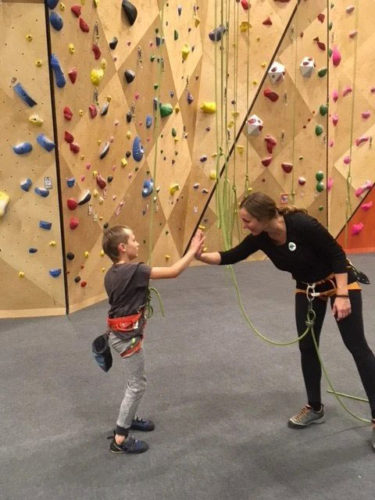
Additionally, for parents of ASD kids, climbing can serve as a welcomed break from an often hectic and rigorous schedule. “As a parent, when you just receive the [autism] diagnosis, you get so scared and worried, but you just have to have fun with your kids too,” Wagner says. “I’m very serious about this because it’s so easy to just run from one therapy appointment to the next, and always work on the kid’s weaknesses. There’s so much of that that people really get into a very stressful dynamic. So, I really would like to see the autism community really value having fun.”
One of the first climbing gyms to embrace Autism Climbs was ABC Kids Climbing in Boulder. In fact, Wagner notes that several years ago, multiple climbing gyms balked at the idea of working with special needs kids, whereas ABC Kids Climbing openly embraced the idea from the get-go. Thus began a main partnership between Autism Climbs and ABC Kids Climbing. Since then, the gym has held periodic educational workshops and frequently featured its own sensory-friendly programming. Going forward, though, the plan is for the Autism Society of Boulder County to take over the community events with ABC.
There is an Olympic connection too, as the ABC Kids brand was started in 2003 by Robyn Erbesfield-Raboutou. Robyn’s daughter, Brooke Raboutou, was the first American climber to qualify for the recently concluded Tokyo Olympics. And another qualified Olympian climber, Colin Duffy, was a product of the ABC Kids Climbing team system too. As a result, ABC Kids Climbing has received unprecedented publicity in the past year, and Wagner hopes some of ABC Kids Climbing’s Olympic buzz will translate to awareness of its autism programming. “[ABC Kids Climbing] always were committed to anybody who wants to climb,” Wagner asserts. “They were just inclusive naturally. And now, fast-forward…what, 15 years? They’re in the Olympics. They’re that good.”
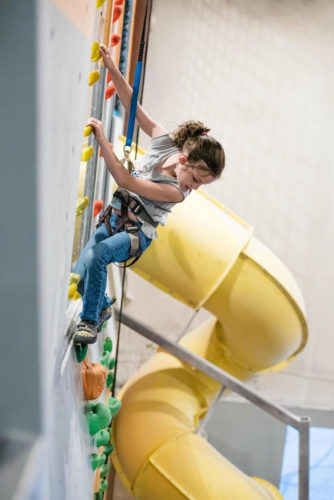
An Opportunity for New Research
From autism advocates and parents to climbing gym operators, practically all who see climbing as a promising support activity for ASD kids feel that more research needs to be done. Aside from a decade-old study from the Department of Psychology at Caldwell College in New Jersey and a couple of more recent, yet broader, papers on ASD and sports participation, in-depth academic exploration of climbing as an autism intervention or therapeutic activity are nonexistent. Most researchers admit that there just is not much available yet; but the recent groundswell of interest could go a long way. “I think this is a really ripe area for exploring what works—and how does it work?” says Dr. Mandy Rispoli, a professor of special education and the Co-Director of the Purdue Autism Research Center. “There’s interest in the community, there’s interest from families, and so, how do we know what to do and how do we know the best way to do it? [It’s] almost like a call to action that this is something that researchers should be attending to and partnering with [climbing] gyms to be able to evaluate how to teach and offer climbing to individuals with ASD.”
The fact that climbing is reaching new levels of popularity—as evidenced by the most recent Gyms and Trends report and record numbers of climbing gyms appearing around the United States, and the sport’s debut in the aforementioned Olympics—could help spur such research partnerships. However, Rispoli notes that autism research can be a slow process, entailing replication in any studies and approval by an institutional review board. The nature of climbing, too, could complicate ethical matters, particularly with getting assent from any ASD participants. As Rispoli postulates, “How are we going to ensure the [ASD] kids are safe as they are learning this skill for the first time—what are you going to do if a child gets high up and then gets scared and can’t communicate? What are the protocols that will be in place? How will you know a non-verbal child wants to participate?”
For those reasons, it could be a decade or more before climbing gets any sort of official endorsement from autism researchers. In the more immediate future, it’s more likely that the grassroots nature of ASD climbing will continue and lead to initiatives outside the research purview. For example, Donelan at Sportrock would like to see the creation of a standardized autism climbing wall that could reside in every climbing gym around the country. The familiarity of the wall would make it particularly welcoming to ASD kids; Donelan likens it to going to any McDonalds around the United States and already being familiar with the menu, and already knowing what to expect. Donelan envisions parents being able to “go to a gym website, click on information and see if the gym has the ‘autism climb.’”
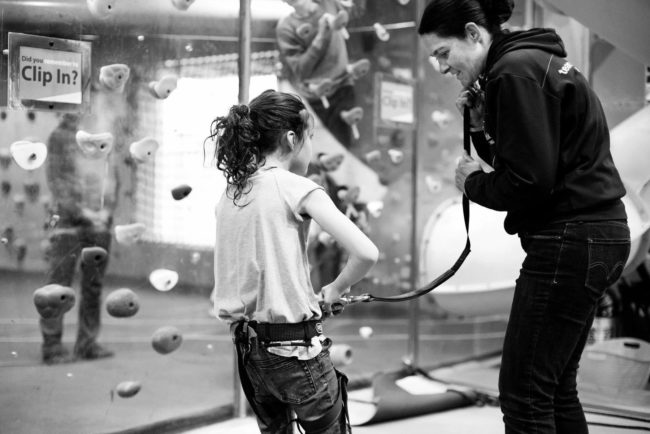
Dr. Matthew T. Brodhead is a behavioral scientist and Assistant Professor at Michigan State University. In addition to being a die-hard climber himself, he is the author of more than 40 peer-reviewed research articles on autism and says he would be willing to lead research studies on climbing and autism in the future. Brodhead acknowledges that most people involved in the organizing and implementation of such grassroots climbing-and-autism endeavors probably mean well, but he urges caution. “When I think about what’s wonderful about this, I think about how disability is part of the human condition, and I’m so excited about anything that embraces disability instead of running away from it—and that autism is helping to normalize disability into the climbing community is something that is really, really special,” Brodhead says. “The yellow flag comes with my own knowledge as a researcher; there are a lot of people in autism ‘treatment’ that are looking to make a buck or capitalize on this increased awareness, and there’s a lot of snake oil that has been sold historically—and has duped parents, and schools, families, kids—into pursuing these treatments that have no therapeutic bent, and might be really expensive, or in some cases harmful.”
Brodhead says it is vital that any coupling of climbing and autism at this juncture be presented for what it is—a form of accommodation, inclusion, and support—unless it is being facilitated by actual trained professionals. And even then, there are complicated questions that must be addressed, as he explains: “There are a lot of things that could be the target or a goal of treatment. Are we here to reduce anxiety? Are we here to increase social interactions or provide a social community? Are we here to help to improve motor movement, coordination? Those are just three things. But those are also deficits that are not necessarily unique to autism.”
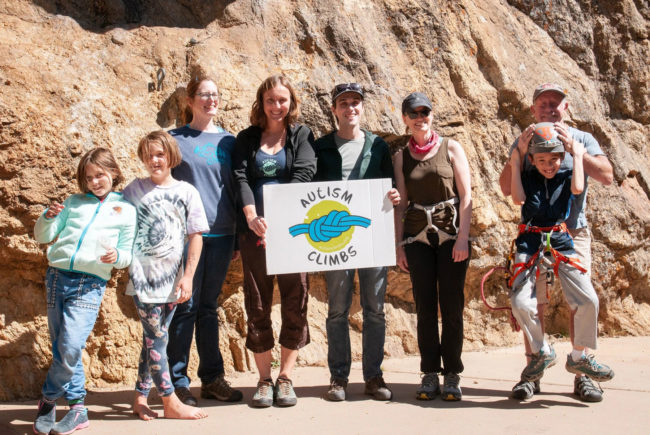
For now, while more groundswell builds and the potential for academic research looms, climbing is a popular new frontier with a lot of promise in the autism sphere. “I’d be hesitant to say climbing could treat autism,” explains Rispoli. “It’s not a cure; it’s not a treatment. But you could use it as a foundation to then provide evidence-based intervention and supports. We know that when kids are highly motivated, they’re more likely to engage in communication and social interaction. So, if a kid loves climbing, that could be a powerful place to deliver intervention. It could be a context within which we could provide what we do know works, in terms of treatment for autism. And I think that’s a really big piece that I think climbing has to offer.”

John Burgman is the author of High Drama, a book that chronicles the history of American competition climbing. He is a Fulbright journalism grant recipient and a former magazine editor. He holds a master’s degree from New York University and bachelor’s degree from Miami University. In addition to writing, he coaches a youth bouldering team. Follow him on Twitter @John_Burgman and Instagram @jbclimbs. Read our interview Meet John Burgman, U.S. Comp Climbing’s Top Journalist.




